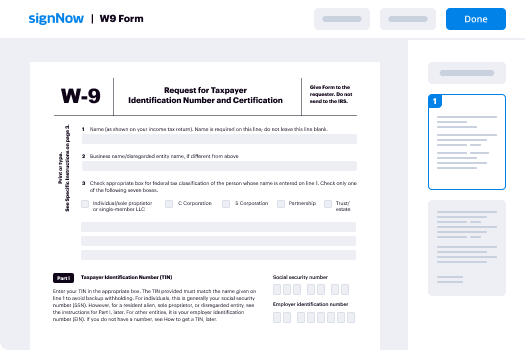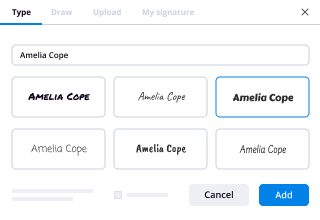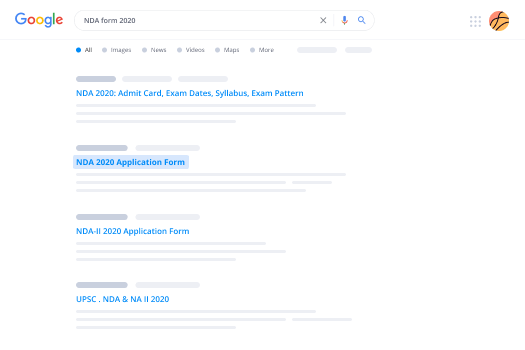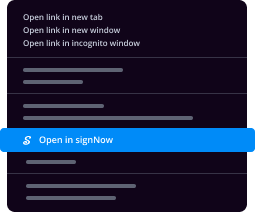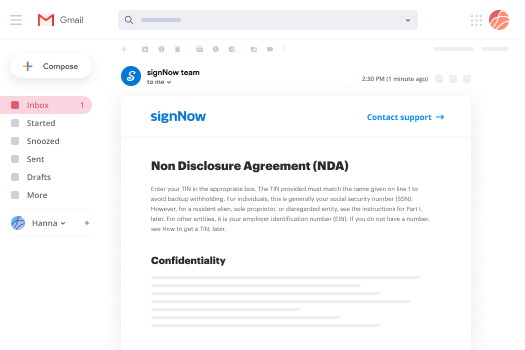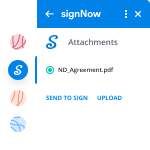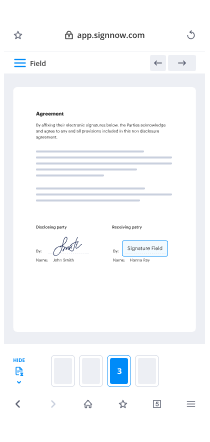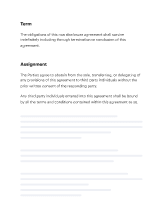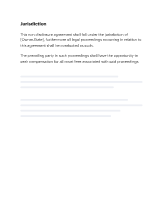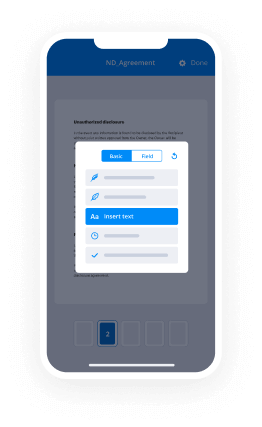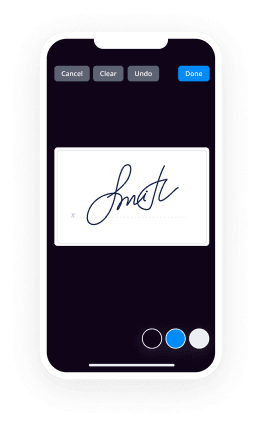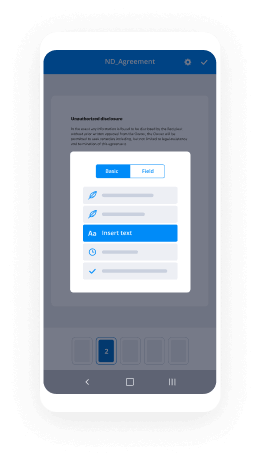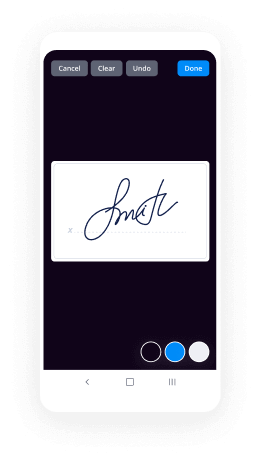Explorez Votre Signature Numérique – Questions Répondues : Loi Sur La Signature Numérique 2000
- Démarrage rapide
- Facile à utiliser
- Support 24/7
Les entreprises qui pensent à l'avance dans le monde entier font confiance à airSlate pour le moment






Guide de démarrage rapide sur l'utilisation de la fonctionnalité de la loi sur la signature numérique de 2000
Votre entreprise est-elle prête à réduire les inefficacités de trois quarts ou plus ? Avec airSlate SignNow eSignature, des semaines d'approbation de contrat se transforment en jours, et des heures de collecte de signatures deviennent quelques minutes. Vous n'aurez pas besoin d'apprendre tout depuis le début grâce à l'interface intuitive et aux instructions faciles à suivre.
Complétez les étapes suivantes ci-dessous pour utiliser la fonctionnalité de la loi sur la signature numérique de 2000 en quelques minutes :
- Lancez votre navigateur et allez sur signnow.com.
- Inscrivez-vous pour un essai gratuit ou connectez-vous en utilisant votre email ou vos identifiants Google/Facebook.
- Sélectionnez Avatar Utilisateur -> Mon Compte dans le coin supérieur droit de la page.
- Personnalisez votre Profil Utilisateur en ajoutant des informations personnelles et en modifiant les paramètres.
- Concevez et gérez votre (vos) Signature(s) par Défaut.
- Retournez à la page du tableau de bord.
- Survolez le bouton Télécharger et Créer et sélectionnez l'option appropriée.
- Cliquez sur la touche Préparer et Envoyer à côté du nom du document.
- Entrez l'adresse email et le nom de tous les signataires dans la boîte pop-up qui s'ouvre.
- Utilisez l'option Commencer à ajouter des champs pour commencer à modifier le fichier et à le signer vous-même.
- Cliquez sur ENREGISTRER ET INVITER une fois terminé.
- Continuez à configurer votre flux de travail eSignature en utilisant des fonctionnalités avancées.
Il n'a jamais été aussi simple d'utiliser la fonctionnalité de la loi sur la signature numérique de 2000. Elle est également accessible sur vos smartphones. Installez l'application airSlate SignNow pour iOS ou Android et gérez vos flux de travail eSignature personnalisés même en déplacement. Évitez l'impression et la numérisation, le remplissage laborieux et la livraison de documents coûteuse.
Comment ça marche
Évaluez votre expérience
What is the digital signature act 2000
The Digital Signature Act of 2000 establishes a legal framework for the use of digital signatures in the United States. It recognizes digital signatures as legally binding, similar to traditional handwritten signatures. This act aims to enhance the security and authenticity of electronic communications and transactions, facilitating the growth of e-commerce and digital interactions. By providing a standardized method for verifying the identity of signers, the act helps ensure that electronic documents are tamper-proof and can be trusted by all parties involved.
How to use the digital signature act 2000
To effectively use the Digital Signature Act of 2000, individuals and businesses must understand the requirements for creating and verifying digital signatures. This includes using secure methods to generate digital signatures, such as public key infrastructure (PKI). Users can create a digital signature by applying a unique cryptographic key to a document, which can then be verified by the recipient using the corresponding public key. airSlate SignNow simplifies this process by providing tools to eSign documents, ensuring compliance with the act while maintaining security and ease of use.
Steps to complete the digital signature act 2000
Completing a document under the Digital Signature Act of 2000 involves several key steps:
- Prepare the document that requires a signature.
- Upload the document to an electronic signature platform like airSlate SignNow.
- Fill out any necessary fields, including names, dates, and other required information.
- Apply your digital signature using the platform's secure signing tools.
- Send the signed document to the relevant parties for their signatures, if needed.
- Store the completed document securely for future reference.
Legal use of the digital signature act 2000
The legal use of the Digital Signature Act of 2000 requires compliance with specific guidelines. Digital signatures must be created using secure methods that ensure the integrity of the signed document. The act mandates that both the signer and the recipient must have access to the necessary technology to create and verify digital signatures. Additionally, organizations must maintain records of the signing process, including timestamps and the identities of all parties involved, to ensure accountability and compliance with legal standards.
Security & Compliance Guidelines
When using digital signatures under the Digital Signature Act of 2000, it is essential to adhere to security and compliance guidelines. This includes:
- Utilizing strong encryption methods to protect the signature and the document.
- Implementing multi-factor authentication to verify the identity of signers.
- Maintaining an audit trail that records all actions taken during the signing process.
- Regularly updating security protocols to protect against emerging threats.
By following these guidelines, users can ensure that their electronic signatures are secure and legally valid.
Documents You Can Sign
The Digital Signature Act of 2000 allows for a wide variety of documents to be signed electronically. Common examples include:
- Contracts and agreements
- Legal documents
- Tax forms
- HR documents, such as employment contracts
- Financial agreements
Using airSlate SignNow, users can easily upload, fill out, and eSign these documents, streamlining workflows and reducing the need for paper-based processes.
Sending & Signing Methods (Web / Mobile / App)
airSlate SignNow offers multiple methods for sending and signing documents electronically, ensuring flexibility for users. Documents can be sent for signature via:
- Web browser: Users can access airSlate SignNow through any web browser to upload and manage documents.
- Mobile app: The airSlate SignNow mobile app allows users to sign documents on the go, providing convenience and accessibility.
- Email: Users can send documents directly via email for signature, making the process simple and efficient.
These methods ensure that users can complete their signing tasks from anywhere, at any time, while remaining compliant with the Digital Signature Act of 2000.
Obtenez dès maintenant des signatures juridiquement contraignantes !
-
Meilleur ROI. Nos clients obtiennent un ROI 7 fois en moyenne au cours des six premiers mois.
-
Échelle avec vos cas d'utilisation. De SMB à moyen marché, airSlate SignNow fournit des résultats pour les entreprises de toutes tailles.
-
Interface utilisateur intuitive et API. Signez et envoyez des documents depuis vos applications en quelques minutes.
Signature en ligne de la FAQ
-
What is the digital signature act 2000?
The digital signature act 2000 is a legal framework that recognizes digital signatures as valid and enforceable in electronic transactions. This act provides the necessary guidelines for the use of digital signatures, ensuring their authenticity and integrity. By complying with this act, businesses can confidently use digital signatures for their documents. -
How does airSlate SignNow comply with the digital signature act 2000?
airSlate SignNow complies with the digital signature act 2000 by implementing secure encryption and authentication methods. Our platform ensures that all digital signatures are legally binding and meet the requirements set forth by the act. This compliance allows businesses to use our solution for their electronic transactions without legal concerns. -
What are the benefits of using airSlate SignNow under the digital signature act 2000?
Using airSlate SignNow under the digital signature act 2000 offers numerous benefits, including enhanced security, faster document turnaround times, and reduced paper usage. Our solution streamlines the signing process, making it easier for businesses to manage their documents efficiently. Additionally, it helps organizations stay compliant with legal standards. -
Is airSlate SignNow cost-effective for small businesses?
Yes, airSlate SignNow is designed to be a cost-effective solution for small businesses looking to utilize digital signatures. Our pricing plans are flexible and cater to various business sizes, ensuring that even small enterprises can benefit from the digital signature act 2000. This affordability allows businesses to save on printing and mailing costs. -
What features does airSlate SignNow offer for digital signatures?
airSlate SignNow offers a range of features for digital signatures, including customizable templates, real-time tracking, and secure storage. These features enhance the signing experience and ensure compliance with the digital signature act 2000. Users can easily create, send, and manage documents all in one platform. -
Can airSlate SignNow integrate with other software?
Yes, airSlate SignNow can seamlessly integrate with various software applications, enhancing its functionality. This integration capability allows businesses to streamline their workflows and maintain compliance with the digital signature act 2000. Popular integrations include CRM systems, cloud storage, and project management tools. -
How secure is airSlate SignNow for digital signatures?
airSlate SignNow prioritizes security by employing advanced encryption and authentication measures to protect digital signatures. Our platform is designed to comply with the digital signature act 2000, ensuring that all transactions are secure and legally binding. Users can trust that their documents are safe and confidential.
Votre guide complet
Rejoignez plus de 28 millions d'utilisateurs airSlate
Obtenir plus
- Légalité de la signature électronique pour les ...
- Déverrouillez le pouvoir de la légalité de la ...
- Légalité de la signature électronique pour la ...
- Déverrouillez la légalité de la signature ...
- Légalité de la signature électronique pour les ...
- Déverrouillez le pouvoir de la légalité de la ...
- Légalité de la signature électronique pour les ...
- Légalité de la signature électronique pour les ...




















